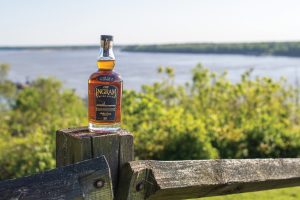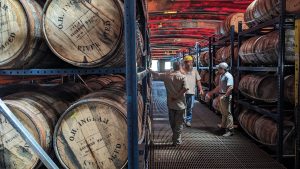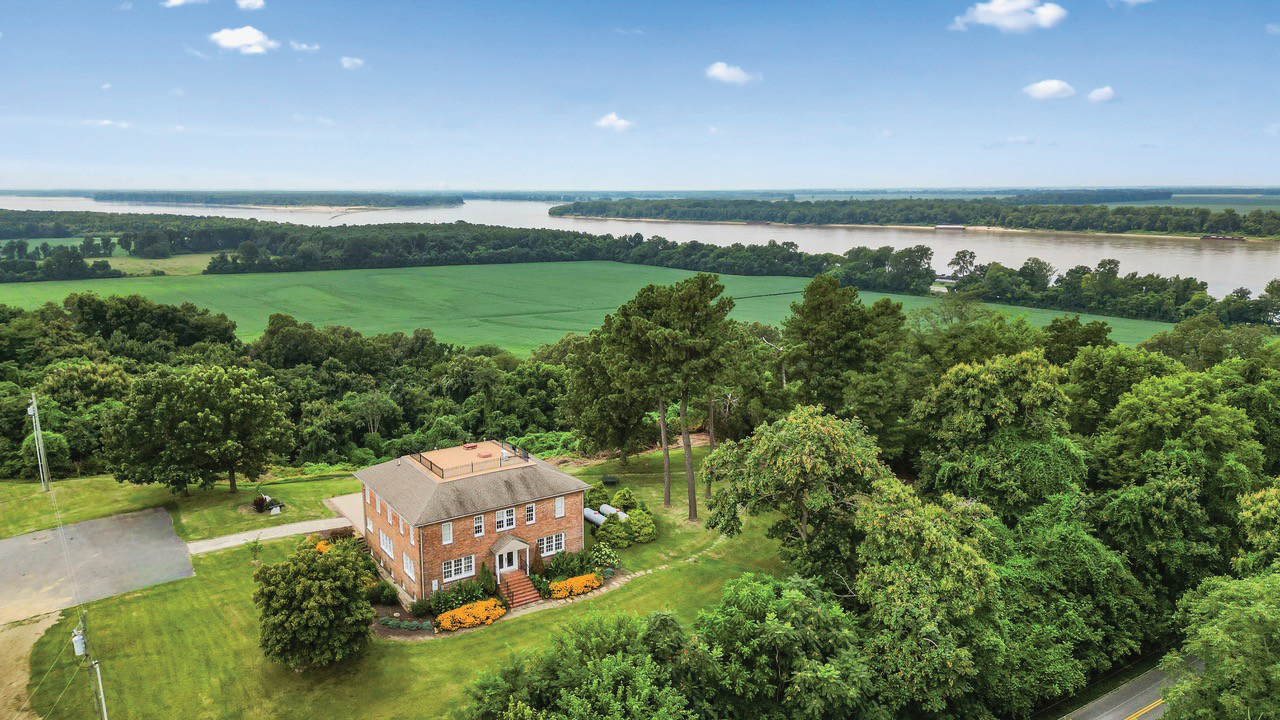A hundred years ago, Columbus, Ky., hugged the banks of the Mississippi River. Founded in 1804 as “Iron Banks” and renamed Columbus in 1820, the town was home to around 600 or 700 people by the early 1920s.
Then came the Great Flood of 1927. According to some accounts, the flood left just 13 of the 150 houses in Columbus livable, and some of the town’s storefronts were swallowed by the swollen river.
With the help of the Red Cross and the federal government, the town relocated upward, over the nearby bluff, safe from future flooding. Directing the relocation effort was Francis Marion Rust from the Red Cross.
As the story goes, Rust fell in love with the town, and his vision for Columbus went beyond helping rebuild the town on higher ground. Rust would later lead early efforts to establish Columbus-Belmont State Park on the site of a Civil War fortification. And in 1930, Rust built the stately Iron Banks Hotel, situated on the bluff in Columbus, overlooking the Mississippi River.
Today, 94 years later, the brick structure remains, offering a commanding view of the Mississippi River and, on the near shore, Ingram Marine Group’s Columbus fleet. No longer a hotel or lodge, the building now serves as an event space and a base of operations for another organization that bears the Ingram name: O.H. Ingram River Aged, a purveyor of bourbon, straight whiskey and rye whiskey.
Acquiring the old Iron Banks Hotel made perfect sense for O.H. Ingram. The company’s two floating barrelhouses, modified barges that can hold a combined 6,000 barrels of whiskey as it ages, are also in Columbus, moored at Ingram Marine Group’s Columbus fleet. O.H. Ingram River Aged moved the floating barrelhouses to Columbus in early 2023, shifting there from James Marine’s fleet in Wicliffe, Ky., to meet growing demand.
River Roots
At the helm of O.H. Ingram River Aged is Hank Ingram, the son of Orrin Ingram II, CEO of Ingram Industries and chairman of Ingram Marine Group. There’s no connection between Ingram Industries and O.H. Ingram River Aged. Hank’s “day job” is leading Ingram Marine Group’s container-on-barge service, acquired from SCF earlier this year.
Hank grew up around the towboat and barge industry, with a family legacy tied to the river that goes back generations. But it wasn’t until his time at Vanderbilt University’s business school that Hank attended a bourbon tasting and learned about the historic connection between bourbon in the United States and the river.

“The story of bourbon getting its start on the river and really being improved by the river resonated with me,” Hank said. “Not a lot of people realize that bourbon got popular for the fact that it could be well distributed beyond Kentucky. That was accomplished, especially in the early years of the late 1700s and early 1800s, by way of the river. These barrels were loaded into flat boats and sent downstream. It took several months for them to ultimately make their way to New Orleans, where upon arrival everybody said, ‘Wow, this whiskey is delicious.’”
Hank decided to explore the effect aging on water versus on land can have on spirits. As it turned out, there were some regulatory hurdles to overcome, namely that it’s illegal to warehouse spirits on a vessel.
“We made the argument that our barges were going to be moored, not in transit,” Hank said. “In fact, there was a Supreme Court case about the time I was pursuing this that said, just because you float, you’re not automatically considered a vessel, so we used that logic and were able to secure a permit.”
At that point, it was just a matter of waiting for the bourbon to age.
“After about six months’ time, we went back and sampled the barrels, both on land and on the barge,” Hank said. “We pretty quickly realized there was something special going on with the river barrels. I knew that was an ‘aha moment’ and that it would be a crime not to pursue it to its logical end. We then used our experimental permit to get an operating permit and began buying bourbon barrels.”
From Barrels To Bottles
That was in 2017. Three years later, in the third quarter of 2020, O.H. Ingram River Aged sold its first bottle of whiskey. Early on, O.H. Ingram sourced its distilled spirits from MGP, a commercial distiller based in Lawrenceburg, Ind. Today, O.H. Ingram’s straight whiskey and bourbon are distilled at Green River Distilling in Owensboro, Ky. Bardstown Bourbon Company in Bardstown, Ky., supplies O.H. Ingram’s rye whiskey. Once barreled at the distilleries, O.H. Ingram’s spirits are sent straight to Columbus and loaded onto the barges, which currently hold around 4,000 barrels of aging spirits.

A bottle of straight bourbon whiskey. (Photo courtesy of O.H. Ingram River Aged)
Overseeing the company’s custom recipes, barreling, aging, blending and bottling is Scott Beyer, O.H. Ingram’s master blender.
Scott and Hank’s friendship goes back to when they were kids at the Ingram family’s ranch in Florida. Scott’s grandfather, who was working at the ranch when the Ingram family acquired it, stayed on to help run it. Fast forward to college years, and Scott and Hank were both in Nashville, with Scott a student at Belmont University and Hank at Vanderbilt.
“When I moved to Nashville, for some side money I worked at Nelson’s Green Brier Distillery,” Scott said. “I was a tour guide to begin with, then moved around in the company. Around 2017, Hank asked if I’d help him rack some barrels.”
As production for O.H. Ingram River Aged ramped up, Scott took the lead on the operations side in terms of the aging, blending and bottling of the spirits. He speaks of the aging and blending process in language that’s equal parts chemistry lecture and poetry.
The temperature and humidity swings on the barge, Scott explained, cause the fibers in the white oak barrels to expand and contract. With the expansion, the wood soaks up the spirits, and as it contracts, the wood forces the spirits back out. That exchange is where much of a barrel of whiskey gets its flavor profile. Once a group of barrels have aged enough, it’s time to blend and experiment with mixing and proofing.
A barrel may taste good on its own, or Scott, Hank and their team may opt for a blend. A blend may have an interesting profile at a particular proof (say, at 100 proof, or 50 percent ABV (alcohol by volume). Another blend may come alive at a lower proof.
“There are so many tools when it comes to doing this,” Scott said. “I think it’s a lot of fun. It can be overwhelming or daunting at first, but once you have a good rhythm and have your own protocol for how you blend, you can really create some fun stuff.”

Scott Beyer (right) and two teammates stand aboard an O.H. Ingram River Aged floating barrelhouse in Columbus, Ky. (Photo by Frank McCormack)
Four years in, O.H. Ingram River Aged offers four products in the retail space: a 105-proof straight bourbon whiskey, a 98-proof straight rye, a 96-proof straight whiskey and a 102.3-proof flagship straight bourbon whiskey. Currently, O.H. Ingram products are available for purchase in Kentucky, Louisiana, Minnesota, Tennessee, Georgia and Wisconsin. O.H. Ingram whiskeys are also available for purchase online, with shipments to 15 states.
And for restaurants, bars and individuals interested in a more exclusive offering, O.H. Ingram River Aged offers private tastings and barrel selections at the lodge in Columbus.
Scott and Hank said the ultimate goal is to have O.H. Ingram River Aged whiskeys available in all 50 states and eventually to grow production to 10,000 barrels. More than anything, they speak of staying true to the company’s river roots and focusing on making a great product. And with that, they’re having great success. The company’s straight bourbon won the Double Gold Award and scored 95 at the San Francisco Spirits Competition this year. The O.H. Ingram River Aged Straight Bourbon also won best in class and a Platinum Award at this year’s SIP Awards. To learn more, visit ingramwhiskey.com.



